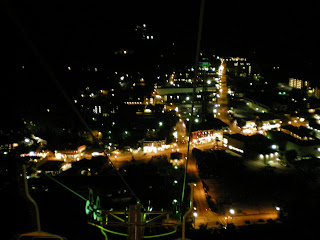 |
| Moving Wall Brochure |
The Moving Wall visited VFW post 1863, Solon, OH, this weekend, July 26th - 29th. It was erected at a long 90 degree angle along the VFW parking lot just down the street from where I worked. I drove to the wall expecting maybe three-foot slabs of two-inch-thick stone standing four feet high to be engraved with names. But the wall was constructed of black-painted sheet metal sections with white screen-printed names in a serif font. I’m not sure what I was expecting; I could not have expected anyone to practically move granite slabs all over the U.S.
The Moving Wall casted a solemn mood, even on a sunny Friday afternoon. The list of names were pennant in shape, beginning with one single name from left (the last soldier), then two listed atop one another, then three listed, four, five, six..... The 90 degree corner was the crux with “1959” describing the descending order from inside out, beginning with the first soldier taken. Volunteers read names alphabetically through a P.A. system in the middle of the parking lot, struggling to get through the Jones and Johnsons while I was there. I think it would have been more natural to read them in order of the wall. Nevertheless, the readings brought a black shroud of remembrance on a sun-shot day typically basked in a haze of forgetfulness as the weekend began.
 |
| The Moving Wall |
I didn’t really know anyone who served in Vietnam---no family, at least. Many, as we know, were drafted from city streets and wheat fields, classrooms and workshops, and deployed in vine-twisted jungles. Ike said, “American boys can’t fight in jungles.” And I think people know (philosophically) well the ground that they toil. My dad graduated from Wynford High School out in the Ohio wheat fields in 1974. The last drawing date of the draft in 1975 was August, 19---his birthday 19 years earlier. 19 was a colossal number for him---he passed away on June, 19.
The names on the wall, I know none and are long gone. JOHN R WILLIAMS might as well have been the guy down the street. I saw my best friend’s dad through the white-serif capital lettering, yelling at us to keep it down because it was 2:00 P.M. and he had to work the conveyor line that night. But life is like the Moving Wall: black, solemn, gone, and full of names. And it keeps moving, giving some more life to the solemn, dead, gone.
The names on the wall, I know none and are long gone. JOHN R WILLIAMS might as well have been the guy down the street. I saw my best friend’s dad through the white-serif capital lettering, yelling at us to keep it down because it was 2:00 P.M. and he had to work the conveyor line that night. But life is like the Moving Wall: black, solemn, gone, and full of names. And it keeps moving, giving some more life to the solemn, dead, gone.














